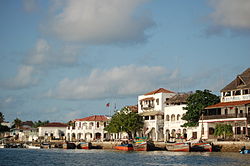Lamu town
| Lamu | |
|---|---|
| Town | |
 |
|
| Location in Kenya | |
| Coordinates: 2°16′10″S 40°54′8″E / 2.26944°S 40.90222°ECoordinates: 2°16′10″S 40°54′8″E / 2.26944°S 40.90222°E | |
| Country |
|
| County | Lamu County |
| Founded | 1370 |
| Time zone | EAT (UTC+3) |
| UNESCO World Heritage Site | |
| Criteria | (ii), (iv), (vi) |
| Reference | 1055 |
| Inscription | 2001 (25th Session) |
|
[]
|
|
Lamu or Lamu Town is a small town on Lamu Island, which in turn is a part of the Lamu Archipelago in Kenya. Situated 341 kilometres (212 mi) by road northeast of Mombasa that ends at Mokowe Jetty from where the sea channel has to be crossed to reach Lamu Island. It is the headquarters of Lamu County and a UNESCO World Heritage site. Lamu is Kenya's oldest continually inhabited town, and was one of the original Swahili settlements along coastal East Africa, founded in 1370.
The town contains the Lamu Fort on the seafront, which commenced construction under Fumo Madi ibn Abi Bakr, the sultan of Pate, and was completed after his death in the early 1820s. Lamu is also home to 23 mosques, including the Riyadha Mosque, built in 1900, and a donkey sanctuary.
Lamu Town on Lamu Island is Kenya's oldest continually inhabited town, and was one of the original Swahili settlements along coastal East Africa. It is believed to have been established in 1370.
Today, the majority of Lamu's population is Muslim.
The town was first attested in writing by an Arab traveller Abu-al-Mahasini, who met a judge from Lamu visiting Mecca in 1441.
In 1505, the Portuguese invaded Lamu, forcing the king of the town to quickly concede to paying protection money to them. The Portuguese invasion was prompted by the nation's successful mission to control trade along the coast of the Indian Ocean. For a considerable time, Portugal had a monopoly on shipping along the East African coast and imposed export taxes on pre-existing local channels of commerce. In the 1580s, prompted by Turkish raids, Lamu led a rebellion against the Portuguese. In 1652, Oman assisted Lamu to resist Portuguese control.
Lamu's years as an Omani protectorate during the period from the late 17th century to early 19th century mark the town's golden age. Lamu was governed as a republic under a council of elders known as the Yumbe who ruled from a palace in the town; little exists of the palace today other than a ruined plot of land. During this period, Lamu became a center of poetry, politics, arts and crafts as well as trade. Many of the buildings of the town were constructed during this period in a distinct classical style. Aside from its thriving arts and crafts trading, Lamu became a literary and scholastic centre. Woman writers such as the poet Mwana Kupona – famed for her Advice on the Wifely Duty – had a higher status in Lamu than was the convention in Kenya at the time.
...
Wikipedia

